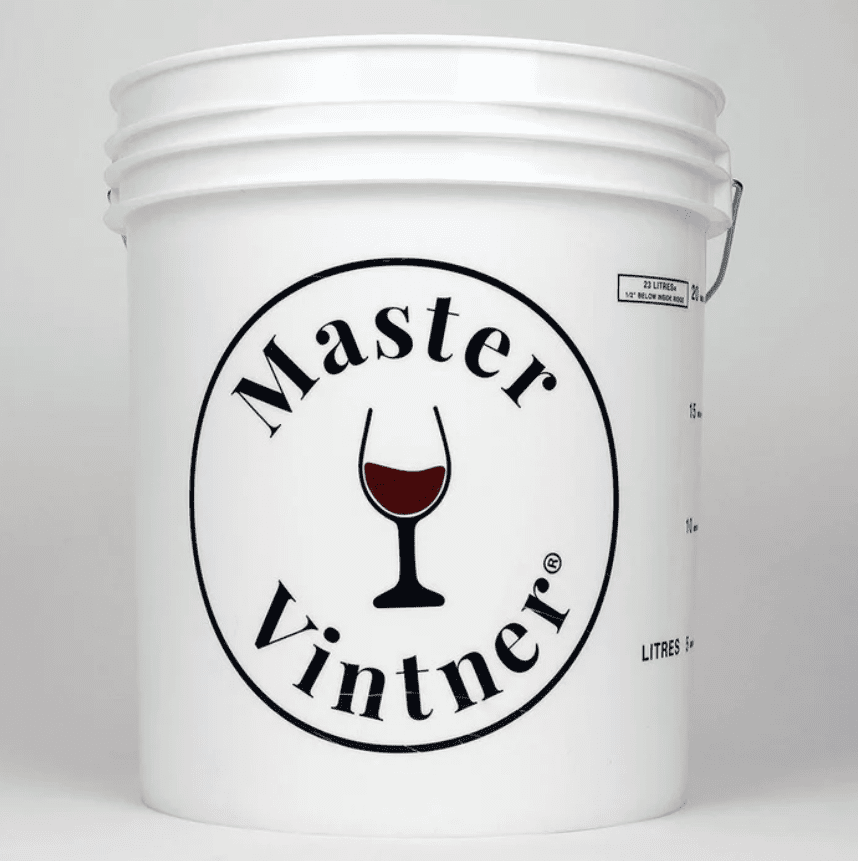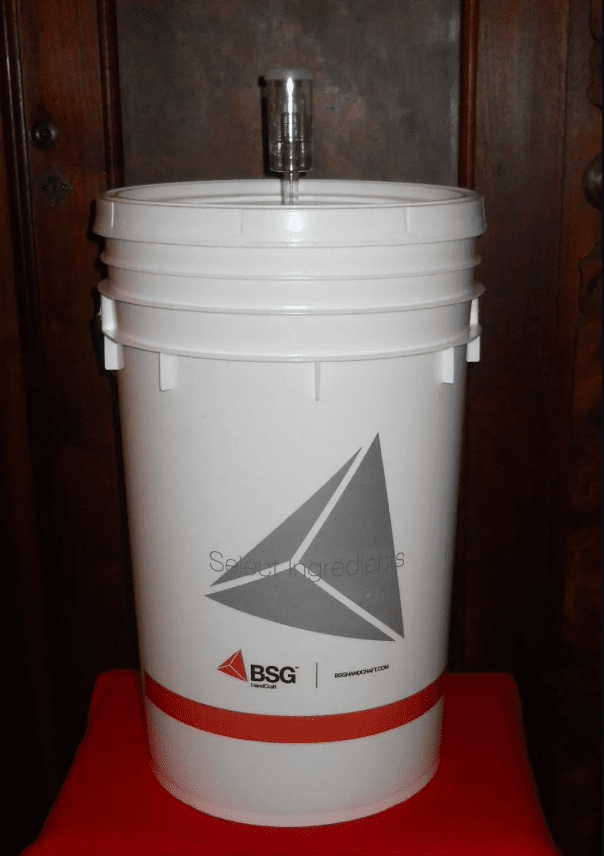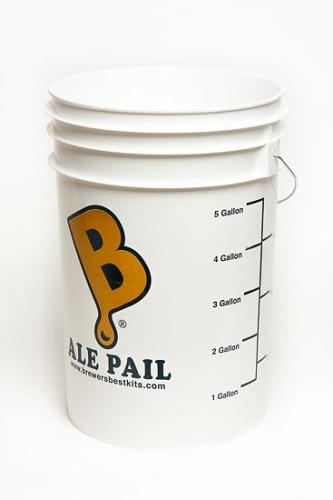- Best Kegerator Cleaning Kits - September 29, 2022
- Best Counter Pressure Bottle Fillers - September 29, 2022
- How to Make Beer Taste Better - August 27, 2022
Finding the best beer bottling buckets is like a fermentation bucket, except it has a spigot at the bottom. This simplifies the bottling process because you only have to connect your tube/wand to the spigot and then turn it open or closed as you move beer into each bottle.
When we bottle, we clear out the dishwasher, set a bucket of Starsan on the side, sanitize the inside of the dishwasher, and then sanitize each bottle and place it on the open door. The bottling bucket goes on the counter directly above, and we sit on matching stools, slowly filling each bottle, capping it, then putting the finished bottles on the top rack.
This makes it a lot easier when unavoidable spills happen; the dishwasher can be put through a rinse cycle but mopping the floor is a huge pain.
Bottom Line Up Front
The MoreBeer Bucket is my favorite because it has a sediment-blocking spigot. Until you have accidentally spilled some bottles with trub, you can’t fully appreciate how great a feature this is.
But, they have slightly limited shipping, so my next favorite option is the Cleveland Brew because they have two different sizes, so you can save money by investing in larger bottling buckets and using them as primary fermenters.
Read also: Comprehensive Guide to Homebrewing Equipment.
Picks at a Glance
Let’s look over the top quality in each of my picks:
- Master Vintner: Larger wine bucket perfect for fermentation and bottling.
- Plastic Bucket: BPA-free plastic, perfect for more professional uses.
- Home Brew Ohio: The markings are right above the spigot and easy to monitor.
- Cleveland Brew: It comes with pre-drilled holes and two sizes for fermentation and bottling.
- MoreBeer Bucket: This one is great because it has a sediment blocking spigot. No trub in your bottles.
Parts of a Beer Bottling Bucket

When looking for the best beer bottling buckets, you will need a bucket with a spigot at the bottom. You will also need a length of tubing that you can attach to the spigot. So, if you already have your tubing, make sure it’s the right size for the spigot on the beer bottling bucket you are considering.
I once made the mistake of not verifying ahead of time and ending up nearly spoiling a batch of beer (I only got about half the amount I should have when all was said and done) because I had to keep one hand tightly over the spigot and the tubing which didn’t quite match, and then try to open and close the spigot with the same hand that was holding the tubing up and filling the bottles. It was chaos. Sticky, sticky chaos.
How to Use the Best Beer Bottling Buckets
A beer bottling bucket is much easier to use than a siphon, especially if you are using 375ml beer bottles. I’ve used a siphon before, and it took the entire day to try and pinch off the hose in between each bottle.
I did the math and realized it was worth the money to invest in a bottling bucket.
Beer bottling buckets are a cinch to use:
- Put your sanitized bottle under the spigot.
- Turn the spigot on (open) until the bottle is full (with headspace).
- Turn the spigot off (closed).
- Sit that bottle off to the side and grab the next one.
Still, some of us are visual learners and need to see how to siphon the beer into a beer bottling bucket. So, I’ve included this quick video:
Bottling buckets can be used as a primary fermenter too. With the spigot, racking is easy. You let the beer ferment, then attach a hose or put the carboy underneath, turn it on (open), and then off when you are done.
Where to Buy a Beer Bottling Bucket
Bear bottling buckets are one of the few things that are really difficult to find on sites like Amazon. When I first started brewing beer, it wasn’t yet in fashion, and you didn’t have microbrews popping up all over the United States, so I couldn’t really find anything online.
For that reason, I ended up with professional wine-making equipment that I used for beer brewing because it was the only available product at the time. They didn’t make cheaper, mass-produced products for enthusiasts or hobbyists.
Today, you are still going to be hard-pressed to find beer bottling buckets on Amazon. I recommend using websites run by brewing supply stores or visiting the suppliers in person if you can.
Brewing suppliers, fermentation suppliers, and even winemakers might have information on where you can purchase the best beer bottling buckets in your area. We have a fermentation supplier in town, and they have an overwhelming inventory of supplies in a far too small space.
When you walk in, it’s tantamount to walking into the storage unit no one knew your grandparents had and trying to delicately create a path through the boxes and boxes of chaos. But, they have everything you need, whether you are making cheese, bread, wine, beer, sauerkraut, or kimchi. And if they don’t have it, they will order it for you.
So if you can’t find the beer bottling bucket you need or the style you want online, consider looking at Shops like these which also have websites through which you can purchase items online. Even if you don’t have a brewing supply company in your area, you can probably find one that will ship to your home.
Tips
- Always buy more beer bottling buckets than you think you will use. The last thing you want is to make a batch that fills your bucket and then some, only to not have enough space for fermentation.
- Have a spare bucket ready with your sanitization mixture, which doesn’t necessarily need to be a beer bottling bucket. We actually keep one of our bottling buckets full of a Starsan mix so that we can sanitize anything around the kitchen at any time and so that we don’t have to make as much during the subsequent steps of bottling in fermentation.
- If you have a heavier bucket, the handle might not be the easiest thing to use to lift it onto or off of a counter. Try carrier straps or a bucket pouring stand.
Selection Criteria
Each of the bottling buckets I included was selected based on the quality of the plastic, what accessories it came with, and how easy it was to use.
Best Beer Bottling Buckets
Master Vintner

For starters, as I’ve mentioned, I use wine buckets. Now, I use them because they were all I could find at the time I started, and now I like that they are large enough for me to ferment and bottle. If you prefer the larger size (and be prepared for a wider bucket overall), you can use Master Vintner.
Pros
- It is 7.9 gallons which means you can use the same bucket for fermenting and bottling (obviously get two buckets because you can’t use them at the same time, you can just use the same type).
- You can buy it with a grommeted lid, a bubbler airlock, or a three piece airlock.
Cons
- You have to buy a siphon and drill it in separately.
Plastic Bucket

This plastic bucket doesn’t check all my boxes, but it made it to the list because it is made with BPA-free food-grade plastic. This is a very important find if you are brewing beer to sell at restaurants or local shops.
A lot of buyers like BPA-free plastic (all of my Camelbak water bottles advertise the same thing). I had two friends in college who started brewing beer for fun back in our home town, and it turned out, people loved it.
Soon enough they received orders for larger batches to be sold at some of the top restaurants in town where all the tourists went (“Oh, isn’t that quaint; locally brewed!”). BUT they had to ensure it was BPA-free plastic because those same tourists (you probably know the type, with their sweaters draped languidly over their shoulders no matter the weather) liked to think their beer was healthier and safer.
So, while it is great for this particular situation, it is oddly twice the cost of most fermenting buckets, which are otherwise exactly the same. And it has a hole for a spigot, but you have to buy your own. Oh, and you have to buy a lid.
Pros
- It is food-grade plastic.
- It has a sturdy metal carrying handle.
- There is a pre-drilled hole.
Cons
- It’s really expensive for something that doesn’t have the lid or the spigot.
Home Brew Ohio

The Home Brew Ohio buckets are 6.5 gallons (so 5 gallons of beer) and come with a lid and spigot.
The container is white with a metal handle for carrying. It is 12 inches tall, so it is easier to wield compared to a carboy. It comes very well reviewed because of how easy it is to clean, how sturdy the material is, and how easy it is to use.
I don’t particularly like that it’s a much darker white than most beer bottling buckets. Bottling buckets are slightly translucent so that you can appropriately read the shadow or line of your liquid as it drops next to the markings on the outside of the bottle. But because this one is a much brighter white, unless you’re working in a kitchen with a lot of fluorescence, you’re going to find it difficult to properly measure.
Pros
- It has a hole in the lid for a grommet.
- The markings are on the right of the spigot, not directly above.
Cons
- It is a bit too small to work as a primary fermenter.
- It is a brighter white, so it is a bit difficult to see how much liquid is left as you are filling bottles.
Cleveland Brew

Cleveland Brew has ale pails bottling buckets. The measurements’ markings are on the bottling buckets’ sides, directly underneath the two points where the solid metal handle inserts. I don’t particularly care for that simply because it’s very far from the spigot, so you kind of has to lean around to either side to see how much beer is left during the bottling process.
It has pre-drilled holes and is moderately inexpensive, but you must purchase the spigot and the lid separately. However, I do like that they are one of the few companies that offer 6.5-gallon buckets and 7.9-gallon buckets. 6.5-gallon buckets are too small to serve as a primary fermenter if you are brewing 5 gallons of beer, but a 7.9-gallon bottling bucket is perfect.
Pros
- They offer two sizes: 6.5 or 7.9 gallons; the 7.9 can easily be used for primary fermentation for a 5-gallon batch of beer.
Cons
- The spigot is sold separately.
- There is no lid on it.
MoreBeer Bucket

The MoreBeer fermenting bucket comes with a spigot. It, like most, is white with markings along the side directly above the spigot. It has an outlet barb into which you can place a 3/8 inch vinyl tube.
Note: if you want to use this bucket for fermentation, you have to buy the lid, stopper, and airlock separately.
When you clean it, don’t use any abrasive pads because any scratches on the inside can become a host for bacteria. Use starsan instead.
Pros
- It has a sediment-blocking spigot, so as you rack for fermentation, you won’t get as much trub in your beer.
- It is a translucent bucket, so it’s a lot easier to see the darker line of your beer as you are bottling, so you know how much is left.
Cons
- It doesn’t come with the lid or airlock.
- They don’t ship everywhere, so you might not find this exact model available in your state.
FAQ
Question: Is a Carboy better than a bucket?
Answer: Carboys are slightly smaller than fermentation buckets. They’re also notoriously slippery and heavy when full, so you’ll definitely want carrier straps. I’ve used car boys instead of beer bottling buckets before when all my buckets were spoken for. It didn’t make as big a batch, and as I mentioned, it was a little bit more difficult to carry, but the tapered neck reduced any unused space and made a nice channel for oxygen to escape through the airlock.
It’s usually better for fermentation rather than for the bottling process. I would advise against using it for bottling because there’s no way for you to attach a spigot, and things can get very messy when you are trying to keep the tubing through the small neck without touching the bottom.
Question: What size are beer bottling buckets?
Answer: This depends entirely on where you purchase and what size you want. In the United States, bottling buckets are usually 5 gallons. They might say 6.5 gallons in size, but that refers to the entire size; the markings for your beer only go up to 5 gallons. They are tall and lean, with a spigot on one end for bottling.
We have much larger polish wine buckets, which are round and short but hold significantly more. So it truly depends on where you buy them, but most beer bottling buckets in America are 6.5 gallons and will hold 5 gallons of liquid.
Question: How much beer does 5 gallons make?
Answer: Five gallons of home-brewed beer will typically make 54 12-ounce bottles or 38 half-liter bottles. If you are planning to share with friends, I recommend using the smaller bottles because then you don’t have to give people as much of your limited production, but you can still be a good friend.
Question: Should I rack beer before bottling?
Answer: Racking your beer to a bottling bucket lets you mix the priming solution in the beer more effectively. Mixing in your priming sugar helps your yeast to carbonate. Just remember, when you are racking your beer, the container you are using has to be several feet higher than the empty vessel into which it is being filled.
Question: Do I need a beer bottling bucket?
Answer: Technically you can use the same bucket for bottling in fermentation, as long as you have the bottling spigot, a lid, stopper, and airlock for the fermentation part of it. Obviously, you are going to need two or more buckets so that you can have one to use for the fermentation and one to use when you rack it and bottle it.
I’ve seen people just drill holes in buckets and attach their own spigots. You can do that. Bottling spigots are relatively cheap, but coming in at about one-third the cost of a beer bottling bucket, you’re better off just picking something that’s manufactured to already have the spigot in place.
Bottom Line
The MoreBeer Bucket is my favorite out of all these picks because it has a sediment-blocking spigot included. However, shipping is slightly more limited.
So, if you need better shipping options, the Cleveland Brew is my second pick, and I love them because they have two different sizes, so you can save money by investing in larger bottling buckets and using them as primary fermentation buckets as well.

